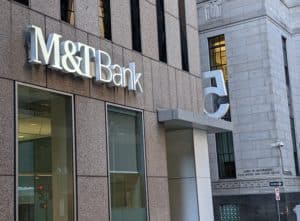In its first earnings call after a major credit ratings agency downgraded its out look for the lender, M&T Bank announced progress in reducing its book of commercial real estate loans.
Citing stress in commercial real estate markets and CRE lending concentration S&P had downgraded its outlook for five regional banks – including Buffalo-based M&T – from “stable” to “negative” in a March 26 report.
In M&T’s quarterly earnings call Monday, bank executives presented figures showing that M&T had shrunk its book of CRE loans from 2 percent to $32.7 billion quarter-over-quarter, down from $35.2 billion compared to the first quarter of 2023.
In addition, the bank’s dollar volume of criticized commercial real estate loans shrank slightly from the fourth quarter of 2023 to the first quarter of this year, from $8.82 billion to $8.54 billion. The reduction, bank executives said, was down to the resolution of three troubled office loans in unspecified cities, although the dollar volumes of criticized health services and office commercial real estate loans both increased slightly.
Of the first quarter’s tally of criticized loans, $2.56 billion were construction loans. Bank executives said they were roughly four-fifths of the way through a review of their construction lending book searching for vulnerabilities, and found few trouble spots.
In total, the bank classified around 26 percent of its CRE loans as “criticized,” or at some risk of default – flat from the prior quarter.
Bank analysts on Monday’s earnings call peppered M&T executives with questions about the bank’s CRE loan book.
In response to a question about how the bank handled the $2.3 billion in commercial real estate loans that had come due in the first quarter, bank executives said around 56 percent of loans were extended after borrowers put up more equity or other collateral “to protect ourselves as we go forward” and 23 percent of the debt that came due was paid off. The bank expects the remainder of the loans that came due in the first quarter to either be extended or paid off, with only a small portion classed as “criticized.”
Another analyst asked M&T’s controller, John Taylor, to compare the volume of criticized loans today to what the bank experienced during the 2008-2009 Great Financial Crisis. Doucette replied that the amount of troubled loans today “are bigger than they were back then,” thanks in part to the far greater impact that crisis had on residential borrowing.
A third asked executives to comment on the March S&P report, to which CFO Daryl Bible said the bank was “very comfortable that that won’t result in a downgrade.”
“We feel very good we’re going to work through the issues. Our customers work with us and put capital in and we’re definitely seeing all our customers and sponsors support these projects,” he said. “It starts with client selection and we have really good client selection…CRE is very manageable and we continue to address that.”
The bank has boosted its provision for credit losses by 67 percent year-over-year, to $200 million, to guard against troubles in its commercial real estate and business lending books.







